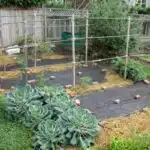Green tomatoes are a common problem faced by gardeners and farmers alike. They are plucked from the vine before they have had the chance to fully ripen, either due to necessity or as a result of early frost. However, an unripe tomato does not have the same flavor and texture as its mature counterpart, which can leave individuals feeling disappointed with their harvest. Fortunately, there are methods for ripening green tomatoes that can allow them to reach their full potential.
As a horticulturalist or plant scientist, it is important to understand the underlying processes that take place within a tomato fruit during ripening. Tomatoes undergo significant physiological changes during this stage, including alterations in color, texture, and taste. The ripening process is initiated by ethylene gas production within the fruit itself, which triggers a series of enzymatic reactions leading to softening and sugar accumulation. Understanding these processes can aid in developing effective techniques for ripening green tomatoes while preserving their quality and flavor.
Understanding Tomato Physiology
Tomatoes are a fruit that undergoes various ripening stages. They start as small, green fruits and gradually mature into large, red, juicy tomatoes. The ripening process is controlled by several factors, including the presence of ripening agents in tomatoes such as ethylene gas and enzymes.
Ethylene gas is naturally produced by the tomato plant during the ripening process. It acts as a signaling molecule that triggers the production of other enzymes responsible for breaking down cell walls and converting starches into sugars. This results in soft, sweet tomatoes that are ready to be consumed.
Enzymes also play an important role in tomato ripening. They catalyze chemical reactions that break down complex molecules into simpler ones, making it easier for the fruit to develop its characteristic flavor and aroma. The activity of these enzymes increases as the tomato matures, leading to changes in color, texture, and taste. Understanding these processes is essential to successfully ripen green tomatoes.
The Ripening Process
Understanding the physiology of tomatoes is crucial when it comes to ripening them. Tomatoes are climacteric fruits, which means they continue to ripen after being harvested. During the ripening process, various stages occur, including the pre-climacteric stage, climacteric stage, and post-climacteric stage. The pre-climacteric stage is characterized by rapid cell division and enlargement, while the climacteric stage marks a peak in respiration rate accompanied by significant changes in color and flavor.
As tomatoes move to the climacteric stage, there are noticeable changes in their color. They transform from green to yellow and then red as carotenoids accumulate in their skin. Ripening also involves other chemical changes like breakdown of chlorophyll and synthesis of pigments like lycopene and beta-carotene. These pigments are responsible for the characteristic red color of ripe tomatoes.
The difference between ripe and unripe tomatoes goes beyond color changes. A ripe tomato has a soft texture while an unripe one is firm; likewise, a ripe tomato has a sweet taste with a pleasant aroma compared to an unripe one that tastes sour or bland with little fragrance. Understanding these differences is vital when it comes to preparing recipes that involve using either ripe or unripe tomatoes.
Differences Between Ripe And Unripe Tomatoes
The texture of ripe tomatoes is generally softer than that of unripe tomatoes. Ripe tomatoes are usually red or yellow in color, whereas unripe tomatoes are green. Ripe tomatoes tend to have a sweeter taste than unripe tomatoes, due to the higher sugar content. Unripe tomatoes are generally firmer and have higher levels of vitamin C than ripe tomatoes.
Texture
When it comes to ripening green tomatoes, texture is an important factor to consider. Ripe tomatoes are typically softer and juicier than unripe ones, which tend to be firmer and less juicy. This difference in texture can affect the taste and overall quality of the tomato once it has fully ripened.
Ripening speed is one of the key factors that can impact the texture of a tomato. Tomatoes that ripen slowly tend to have a firmer texture than those that ripen quickly. This is because slow-ripening tomatoes have more time to develop their cell walls, which make them sturdier. Conversely, rapid-ripening fruits tend to have thinner cell walls and a softer texture.
When determining whether or not a tomato is ripe, there are several indicators to look for beyond just its firmness or softness. A ripe tomato will typically have a vibrant color, ranging from deep reds to bright yellows or oranges depending on the variety. It should also give slightly when gently pressed, indicating that it is full of juice. By paying attention to these ripeness indicators and adjusting your ripening process accordingly, you can ensure that your green tomatoes develop the ideal texture for your desired dish without sacrificing flavor or quality.
Color
Tomato color is a significant ripeness indicator that can help identify whether a tomato is mature or not. The color development of tomatoes varies depending on the variety and environmental factors such as temperature, sunlight exposure, and soil nutrients. Generally, unripe tomatoes are green, while ripe ones vary from deep red to yellow or orange shades. As the tomato matures, chlorophyll production decreases, allowing other pigments such as carotenoids and anthocyanins to dominate and create a more vibrant color.
The change in tomato color during ripening is caused by several chemical reactions involving enzymes and pigments. For example, lycopene is a pigment responsible for the red color of mature tomatoes. During ripening, enzymes break down the cell walls around the lycopene-containing vesicles within the fruit’s cells, freeing up lycopene molecules to contribute to the reddening process. In contrast, green tomatoes contain more chlorophyll than ripe ones because they have not yet undergone this enzymatic breakdown.
When selecting tomatoes for consumption or cooking purposes, it is crucial to consider their color carefully. Although some recipes may call for green tomatoes specifically, most dishes require fully ripe ones with rich colors indicative of flavor intensity and sweetness. Additionally, overexposure to light or extreme temperatures can affect tomato color development and result in uneven ripening or blemishes that compromise their quality. Therefore, it’s paramount to store them appropriately and harvest at peak maturity for optimal taste and texture.
Factors Affecting Ripening
Ripening is a complex process influenced by several factors. The most important factors affecting ripening are temperature, humidity, and ethylene gas. Temperature plays a crucial role in the rate of ripening as it affects the activity of enzymes responsible for the breakdown of cell walls and chlorophyll degradation. Optimal temperatures for tomato ripening range between 15-25°C. However, temperatures above or below this range can slow down the ripening process.
Humidity is another factor that influences the rate of tomato ripening. High humidity levels can cause mold growth and spoilage while low humidity levels can lead to dehydration of the fruit, reducing its quality. Moreover, ethylene gas is essential for initiating and accelerating tomato ripening. Ethylene is naturally produced by ripe tomatoes and can also be artificially induced using ethylene generators or sprays.
To speed up the ripening process, there are a few simple techniques that one could use such as storing green tomatoes in a warm place with high humidity levels or exposing them to ethylene gas from ripe fruits. Additionally, wrapping green tomatoes in newspaper or placing them in a paper bag with an apple can help trap natural ethylene gas produced by apples which can stimulate the ripening process.
In summary, understanding the factors affecting tomato ripening is crucial to ensure optimal fruit quality and yield. By controlling environmental conditions such as temperature and humidity or inducing ethylene gas production through various methods, it’s possible to speed up tomato ripening without compromising on quality or taste.
Transition: Understanding how to influence tomato ripening is crucial before harvesting green tomatoes.
Harvesting Green Tomatoes
- When selecting green tomatoes, it is important to look for firm, unblemished fruits and to avoid any that are overly soft or have blemishes.
- The storage conditions for green tomatoes should be kept between 55 and 65 degrees Fahrenheit, with relative humidity of 85-90% in order to slow the ripening process.
- Ripening techniques may include enclosing the tomatoes in a paper bag or cardboard box with a ripe apple or banana to hasten ripening.
- The addition of ethylene gas to the ripening environment can also be used to accelerate the ripening process.
- Ripening can also be accelerated by placing the tomatoes in direct sunlight for a period of time.
- It is important to check the tomatoes daily for ripeness and to remove any that have reached the desired ripeness in order to prevent over-ripening.
Selecting Green Tomatoes
As a horticulturist, selecting green tomatoes can be quite challenging. To ensure that the ripening process is successful, it is important to understand tomato ripeness levels and the visual cues for tomato ripeness. When selecting green tomatoes, it is crucial to choose those that are mature and have reached their full size but have not yet begun to change color.
One of the most reliable visual cues for tomato ripeness is the presence of a pink or reddish blush on the fruit’s skin. As the fruit ripens, this blush will spread and deepen in color until the entire fruit changes color. When selecting green tomatoes, look for those with a slight pink or reddish hue on their skin as this indicates they are closer to reaching maturity. Additionally, avoid tomatoes with blemishes or bruises on their skin as these may not ripen properly.
Another visual cue to consider when selecting green tomatoes is its overall texture and firmness. Ripe tomatoes typically have a soft texture when gently squeezed while unripe ones are harder. However, it is important not to choose overly soft green tomatoes as these may be too ripe and spoil faster during the ripening process.
In conclusion, selecting green tomatoes that are mature in size but have not yet begun changing color, possess a slight pink or reddish hue on their skin, and have an overall firm texture is crucial for successful ripening. By understanding these visual cues for tomato ripeness, individuals can enjoy delicious ripe tomatoes even after harvesting them while still unripe from their gardens.
Storage Conditions
As a horticulturalist, understanding the proper storage conditions for green tomatoes is essential for successful ripening. The right humidity control and temperature regulation can make all the difference in preserving the quality of the tomatoes while they ripen.
One important factor to consider in storing green tomatoes is humidity control. Too much moisture can cause mold or rotting, while too little can cause wilting or shriveling. To avoid these issues, it is recommended to store green tomatoes in a cool and dry location with moderate humidity levels. A good rule of thumb is to maintain a relative humidity between 80-90% to ensure optimal ripening without any negative effects.
Temperature regulation is another crucial aspect of storing green tomatoes for ripening purposes. Tomatoes are sensitive to extreme temperatures; therefore, it is essential to keep them at an ideal temperature range that promotes proper ripening without causing damage. It is best to store green tomatoes at room temperature between 60-70°F (15-21°C) as this allows them to ripen slowly and naturally without overripening or spoilage.
In summary, maintaining the right humidity levels and temperature range when storing green tomatoes will enable them to ripen successfully and retain their quality until ready for consumption. Proper storage conditions are crucial for ensuring that your harvested green tomatoes turn into delicious, juicy ripe ones that can be enjoyed by you or served to others with satisfaction and delight.
Ripening Techniques
Tomato maturity is a crucial factor to consider when harvesting green tomatoes. Tomatoes are considered mature when they have reached their full size and have begun to change color. When harvesting green tomatoes, it is important to choose those that have reached maturity and show ripeness indicators such as a slight yellowing or blush on the skin.
Once harvested, green tomatoes can be ripened using several techniques. One popular method is placing them in a paper bag with an apple or banana. The ethylene gas produced by the fruit helps accelerate the ripening process of the tomatoes. Another technique involves wrapping each tomato individually in newspaper and storing them in a cool, dark place until they ripen naturally.
It is essential to check on the ripening progress regularly and remove any overripe or spoiled ones promptly to avoid spoilage of other tomatoes. With proper ripening techniques, harvested green tomatoes can transform into sweet, juicy ripe ones that are perfect for consumption or serving to others with satisfaction and delight.
Storing Green Tomatoes
Storing green tomatoes properly is essential to extend their shelf life and avoid spoilage. There are various techniques that can be applied to store green tomatoes safely. One of the most effective methods is to wrap each tomato individually in newspaper or brown paper bags, which helps prevent moisture loss and protect them from light. This technique helps maintain the freshness of the tomatoes for up to four weeks when kept in a cool, dark place such as a basement or pantry.
Another technique that can be used to store green tomatoes is by placing them in a cardboard box lined with newspaper or straw. The tomatoes should be arranged in a single layer with a small gap between them to allow air circulation. The box should then be covered with another layer of newspaper or straw before being stored away from direct sunlight. This method provides an ideal environment for the tomatoes as it allows proper ventilation while protecting them from excessive moisture.
When storing green tomatoes, it is important to inspect them regularly for any signs of decay or over-ripening. Any damaged or spoiled fruits should be removed immediately to prevent further damage and spoilage. With these simple storing techniques, green tomatoes can last for several weeks, giving ample time for ripening naturally at room temperature or through exposure to ethylene gas.
Transition: Now that we have explored different storing techniques for green tomatoes, let’s delve into how ethylene gas plays a role in ripening these fruits.
Ethylene Gas And Ripening
After storing green tomatoes, the next step is to ripen them. Ethylene gas is a natural plant hormone that plays an essential role in fruit ripening. It triggers a series of biochemical reactions that lead to changes in color, texture, and flavor of fruits. To ripen green tomatoes artificially, you can use ethylene gas produced by fruits such as bananas or apples.
There are different methods of using ethylene gas for ripening green tomatoes. One common method is placing unripe tomatoes in a paper bag with a ripe banana or apple. The fruits release ethylene gas, which will be trapped inside the bag and accelerate the ripening process of the tomatoes. Alternatively, you can put the green tomatoes together with ripe fruits in a closed container and place it in a warm area for several days until they turn red.
While using ethylene gas is an effective way of ripening green tomatoes, there are other natural techniques you can try at home. For instance, you can place unripe tomatoes on a windowsill or any other warm spot in your house with sufficient sunlight exposure. The warmth and light will stimulate the production of natural ethylene gas within the tomato and speed up its maturation process. Moreover, storing fresh basil leaves with unripe tomatoes can also accelerate their ripening due to compounds present in basil leaves that trigger fruit maturation processes.
Moving on from artificial methods of ripening green tomatoes through using ethylene gas techniques, let us take a look at natural ways to expedite this process without involving any external methods or substances but only utilizing nature’s resources available around us.
Natural Ripening Methods
Harvesting timing is an important factor in ripening green tomatoes naturally, as tomatoes that are picked at the right time have the best chance of ripening properly. Sun exposure is also a key factor, with tomatoes that receive at least 8 hours of full sun exposure per day being more likely to ripen naturally. Temperature control is also important, as tomatoes should be stored at temperatures between 55 and 85 degrees Fahrenheit in order to ripen properly. Finally, humidity levels should remain between 80 and 95 percent for successful ripening.
Harvesting Timing
Green tomatoes are a common sight in gardens and markets, but the challenge lies in ripening them naturally. One of the most critical aspects of natural ripening methods is harvesting timing. To ensure that your green tomatoes ripen to perfection, you need to pick them at the right time. Ideal temperatures for tomato harvest range between 50-85°F, with 60-70°F being optimal. When selecting green tomatoes for ripening, look out for signs of readiness such as plumpness and firmness.
To guarantee successful natural ripening of green tomatoes, it is essential to understand their harvesting timing fully. Timing is critical as it determines whether you will get perfectly ripe tomatoes or not. The ideal time to pick green tomatoes depends on their variety and prevailing weather conditions. Typically, you should wait until the fruits have reached full size and developed a slight yellow tinge on their skin before picking them.
In conclusion, harvesting timing plays a crucial role in successfully ripening green tomatoes naturally. For optimal results, choose an ideal temperature range and pay close attention to signs of readiness when selecting your fruits for ripening. By following these guidelines, you can enjoy delicious ripe tomatoes from your garden or kitchen all year round!
Sun Exposure
Tomatoes are one of the most popular crops grown in gardens and farms all over the world. They are known for their delicious flavor and versatility in cooking. Natural ripening methods have gained popularity among tomato growers because they allow tomatoes to ripen naturally without using chemicals that may harm humans or the environment. One factor that greatly influences natural ripening is sun exposure.
Using heat from the sun is an effective method of ripening green tomatoes naturally. Tomatoes need sunlight to produce sugar, which is essential for ripening. When exposed to sunlight, green tomatoes undergo a process called photomorphogenesis, where they change color from green to red, yellow, or orange. However, too much sunlight can cause sunscald on fruits, resulting in uneven ripening or rotting. It is recommended to provide shade for tomatoes during hot summer days to regulate their exposure to sunlight.
Using chemicals such as ethylene gas is another method of natural tomato ripening. Ethylene is a plant hormone that stimulates fruit ripening by activating enzymes responsible for breaking down cell walls and converting starches into sugars. Green tomatoes release little amounts of ethylene gas, which means that they require external sources of ethylene to trigger natural ripening fully. Tomatoes can be exposed to ethylene gas by placing them in a brown paper bag with ripe bananas or apples overnight or by exposing them to exhaust fumes from a running car engine for several minutes. However, caution should be taken when handling ethylene gas as it poses health risks when inhaled at high concentrations.
In summary, using heat and chemicals are two methods of natural tomato ripening that work efficiently when applied correctly. Sun exposure influences tomato ripening significantly and should be monitored closely during hot summer days. Meanwhile, ethylene gas triggers natural tomato ripening by activating enzymes responsible for breaking down cell walls and converting starches into sugars but should be handled with care due to its potential health hazards.
Paper Bag Method
Picture this: a bag full of green tomatoes sitting on your kitchen counter. You’re eager to enjoy the delicious fruit, but they just won’t ripen fast enough. Don’t worry, the paper bag method may be just what you need to speed up the process.
To use the paper bag method, simply place your green tomatoes in a paper bag and fold over the top to seal it closed. The moisture control provided by the paper bag helps to trap ethylene gas, which is naturally produced by ripening fruits. This gas speeds up the ripening time of your tomatoes.
Here are three tips to make sure you get the best results with this method:
- Use a brown paper bag instead of a plastic one to allow for proper air circulation.
- Add an apple or banana to the bag with your tomatoes, as these fruits also produce ethylene gas and will help speed up the ripening process even more.
- Check on your tomatoes every few days and remove any that have started to rot or go bad.
Next up, we’ll explore another popular method for ripening green tomatoes: the banana method.
Banana Method
The banana method is another alternative way to ripen green tomatoes. It involves placing a ripe banana in a paper bag with the tomatoes and sealing the bag. The ethylene gas released by the banana will help to speed up the ripening process of the tomatoes. This method is effective because bananas are known to produce a lot of ethylene gas, which is an important hormone that regulates various physiological processes in plants.
To use this method, select a ripe banana that has started to show signs of aging, such as brown spots on its skin. Place the banana inside the paper bag with the green tomatoes and seal it tightly. It’s important to make sure that there is enough space in the bag for air circulation. Leave the bag at room temperature for 24-48 hours and check on them periodically until they have reached your desired level of ripeness.
While using bananas to ripen green tomatoes is effective, there are other alternative methods worth exploring. For example, you can also use apples or avocados as a substitute for bananas. These fruits also produce ethylene gas and can be used in a similar manner as bananas. Ultimately, it’s important to choose a method that works best for you and your specific situation.
Moving forward, let’s explore another popular method for ripening green tomatoes – sunlight method.
Sunlight Method
When ripening green tomatoes using the Sunlight Method, timing is an important factor to consider. The length of time tomatoes spend exposed to sunlight can affect the ripening process. Longer exposure to sunlight is usually necessary for green tomatoes to ripen. Additionally, the intensity of the light is crucial; direct sunlight is recommended for the ripening process. Temperature is also an important factor to account for when ripening tomatoes – temperatures should be consistently warm, preferably between 68 and 77 degrees Fahrenheit. With the right timing, light exposure and temperature, the Sunlight Method can be an effective way to ripen green tomatoes.
Timing
In order to achieve optimal ripening of green tomatoes using the sunlight method, timing is a critical factor to consider. Determining maturity is essential for this technique to be successful. In general, it takes approximately two weeks for green tomatoes to reach their full maturity and begin the ripening process.
The first step in timing the sunlight method is to determine the date when the first frost is expected in the area. It’s important to harvest green tomatoes before the first frost as they won’t ripen once they have been damaged by cold temperatures. Once this date has been established, count back two weeks from that date, and that will be the ideal time to pick your green tomatoes.
It’s important to note that not all green tomatoes are created equal, so determining maturity requires a bit of experience and knowledge about tomato varieties. Generally speaking, mature green tomatoes will have a slight yellow or pink tint on their skin and will be firm but not rock hard. With practice, gardeners can quickly learn how to identify mature green tomatoes and time their harvesting appropriately for optimal ripening using the sunlight method.
Light Exposure
Tomato ripening stages can be influenced by various factors, including light exposure. The sunlight method is a technique that aims to ripen green tomatoes using natural light exposure. To achieve optimal results, it’s important to understand the role of light in the tomato ripening process.
Tomatoes require specific wavelengths of light to trigger their ripening process, which is why they are often categorized as either red or green. Red tomatoes need longer periods of direct sunlight exposure to maintain their color and flavor, while green tomatoes require shorter periods of indirect sunlight exposure to initiate the ripening process. This is where the sunlight method comes into play.
The sunlight method involves placing green tomatoes in a sunny location for a few hours each day. This allows them to receive adequate amounts of indirect sunlight exposure, which stimulates the release of ethylene gas – one of the primary tomato ripening agents. By gradually increasing the amount of time they spend in direct sunlight over several days, gardeners can effectively control the ripening process and produce perfectly ripe tomatoes with ideal flavor and texture.
Temperature
As horticulturalists, we understand that tomato ripening stages can be influenced not only by light exposure but also by temperature. Optimal storage conditions are essential in maintaining the quality and flavor of ripe tomatoes. Tomatoes are sensitive to extreme temperatures, and exposure to high or low temperatures can significantly affect their ripening process.
Temperature plays a crucial role in the tomato ripening process. The ideal temperature range for ripening tomatoes is between 68-77°F (20-25°C). In colder temperatures, the ripening process slows down, while higher temperatures can cause overripening or spoilage. It’s important to note that once the tomatoes have fully ripened, they should be stored at cooler temperatures of around 50-55°F (10-13°C) to maintain their flavor and texture.
When using the sunlight method in combination with optimal temperature conditions, gardeners can achieve perfectly ripe tomatoes with ideal flavor and texture. By placing green tomatoes in a sunny location for a few hours each day and storing them at the ideal temperature range during the ripening process, they can effectively control the ripening stages and produce high-quality fruit. With this knowledge, gardeners can effectively serve others by providing fresh and delicious homegrown tomatoes.
Artificial Ripening Methods
When natural ripening methods fall short, artificial ripening methods can be employed to hasten the process of ripening tomatoes. Using chemicals is one such method that has been practiced for a long time. One chemical commonly used is ethephon, a plant hormone which aids in the release of ethylene gas that triggers tomato ripening. Ethephon is sprayed on the green tomatoes and left to work its magic over a period of time. Within a few days, the tomatoes will start to turn red.
However, there are risks involved when using chemicals to ripen tomatoes artificially. The presence of residual chemicals in or on the fruit can pose health hazards both to humans and animals. Consuming fruits that have been exposed to such chemicals can lead to health issues such as respiratory problems and even cancer. It is imperative therefore that excessive use of these chemicals be avoided at all costs.
To ensure safety while using artificial ripening methods, it is important to follow recommended dosages as well as adhere strictly to guidelines provided by regulatory authorities. Additionally, thorough washing of tomatoes before consumption helps reduce exposure to harmful residues.
- Always read and follow instructions carefully when using any chemical.
- Use protective gear when handling chemicals.
- Store all chemicals safely out of reach of children and pets.
With caution exercised while using artificial ripening methods, it is possible to enjoy ripe juicy tomatoes even when they would otherwise not mature naturally.
The next section will discuss an alternative way of ripening your green tomatoes – the oven method.
Oven Method
Artificial Ripening Methods are used to accelerate the ripening process of green tomatoes. One of the most popular methods is the Oven Method. This method involves placing green tomatoes in a paper bag and keeping them in the oven for a certain period.
Temperature regulation is an important factor in this method. The oven should be set to a low temperature between 55-60 degrees Celsius. Leaving them for too long or setting the temperature too high can cause the tomatoes to over-ripen or burn, respectively. On average, it takes about two weeks for green tomatoes to ripen using this method.
Ripening time may vary depending on factors such as tomato variety and maturity level at harvest. It is essential to check on them regularly and remove any ripe ones so that they do not over-ripen and spoil the rest of the batch. Once they have reached their desired ripeness, they can be stored at room temperature or refrigerated until ready for use.
Transition: Another artificial ripening method you can consider is the microwave method.
Microwave Method
The microwave method is one of the simplest ways to ripen green tomatoes. It involves heating the fruit in a microwave oven for a few seconds or minutes, depending on its size and ripeness level. This approach is a popular choice because it can quickly soften and sweeten the tomatoes, making them ready for consumption.
However, like any other technique, there are benefits and drawbacks to using the microwave method for ripening green tomatoes. One of its advantages is that it saves time and effort since it only takes a few minutes to ripen the fruit. Another benefit is that it can also preserve some of the nutrients found in fresh tomatoes, such as vitamin C.
On the downside, using this method can also have some drawbacks. For instance, if not done correctly, microwaving tomatoes can cause them to burst or become too soft. Additionally, this technique may affect some of the tomato’s flavor and texture profiles, which may not be desirable for some people. Overall, whether you choose to use this method or not depends on your personal preferences and circumstances.
In conclusion and recommendations for those who choose to use this method: when microwaving green tomatoes for ripening purposes, consider starting with shorter durations at lower power levels first before gradually increasing both values until you find what works best according to your preference; check often while cooking so as not to over-ripen or burn them; experiment with different types of green tomatoes (e.g., cherry vs. regular) to see how they respond differently to microwaving; finally, always remember that microwaving is just one option among many others that you can use for ripening green tomatoes!
Conclusion And Recommendations
To conclude, ripening green tomatoes can be a straightforward process if done correctly. Understanding the factors that affect the ripening rate of tomatoes is crucial to ensuring optimal ripeness. The temperature and humidity levels play a significant role in determining how quickly or slowly green tomatoes will ripen.
When storing green tomatoes, it is best to avoid direct sunlight and store them at room temperature. This method allows for gradual ripening and helps preserve their flavor. Alternatively, placing ripe fruit nearby can speed up the process due to the release of ethylene gas.
In recommendations, it is advised to inspect stored tomatoes regularly for any signs of decay or spoilage. Discard any damaged or rotten fruits immediately to prevent contamination of healthy ones. In summary, with proper storage techniques and careful monitoring of environmental conditions, anyone can successfully ripen their green tomatoes to achieve optimal flavor and texture without much hassle.
Conclusion
Tomatoes are one of the most popular vegetables in the world, and come in many different shapes, sizes, and colors. However, green tomatoes can pose a bit of a challenge for gardeners and growers. Understanding tomato physiology is crucial to finding the best way to ripen green tomatoes. The ripening process is complex and involves several factors that affect the outcome.
Differences between ripe and unripe tomatoes include color, texture, taste, and nutritional content. Factors affecting ripening include temperature, humidity, light exposure, and ethylene gas production. Harvesting green tomatoes at the right time is important to ensure that they will ripen properly. Artificial ripening methods such as the oven or microwave method can be used if necessary.
In conclusion, it is essential to have an understanding of tomato physiology to effectively ripen green tomatoes. The process involves numerous factors that must be taken into account for successful results. By harvesting at the right time and utilizing artificial methods when necessary, gardeners and growers can enjoy ripe and delicious tomatoes all year round. As plant scientists or horticulturalists, we must continue to study tomato physiology to discover new ways to optimize their growth and improve their quality. What other methods could be used to effectively ripen green tomatoes?
Image Credits
- “Baked Salmon, Creamy Dill Sauce, Spinach, Green Beans, Tomatoes” by diettogo1 (featured)





























